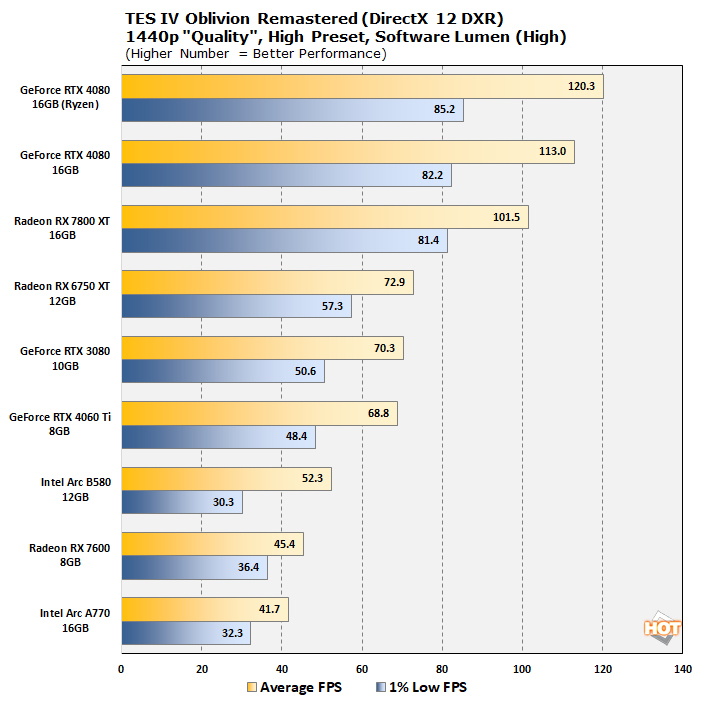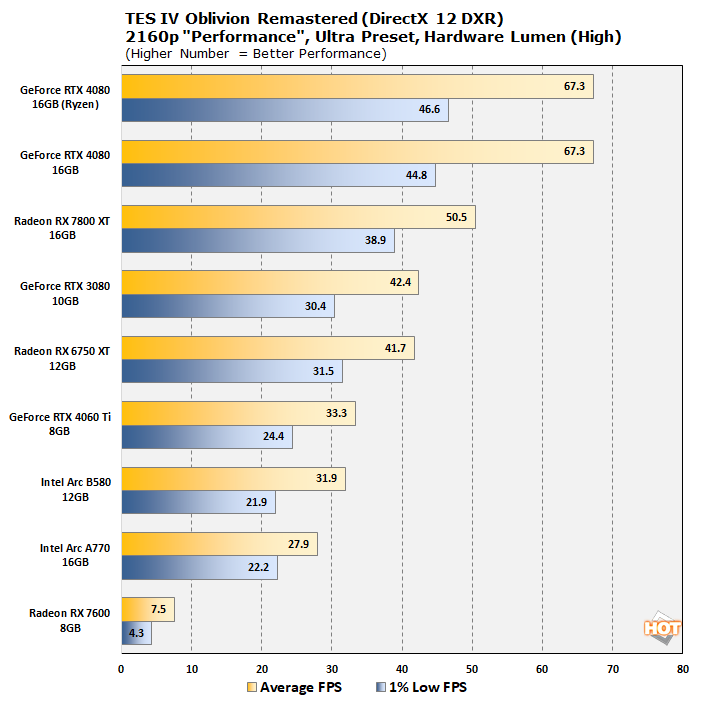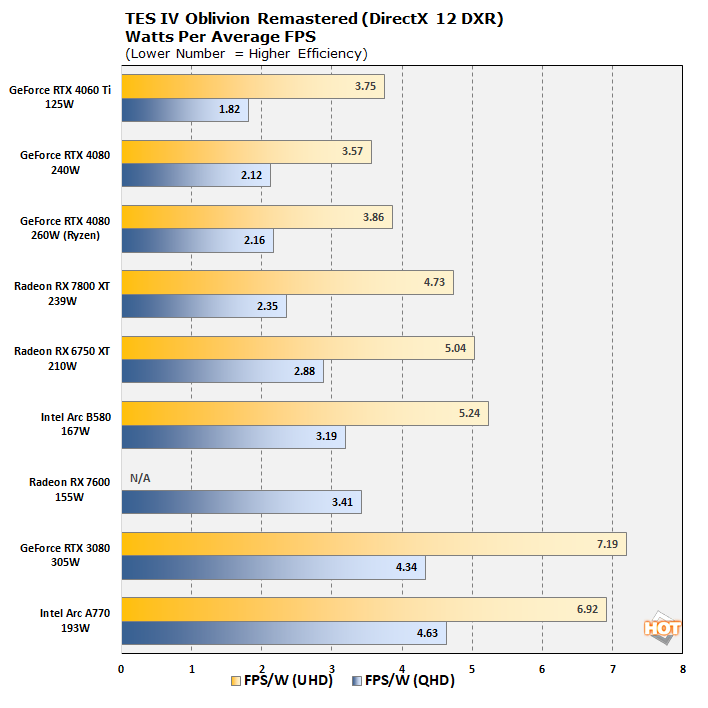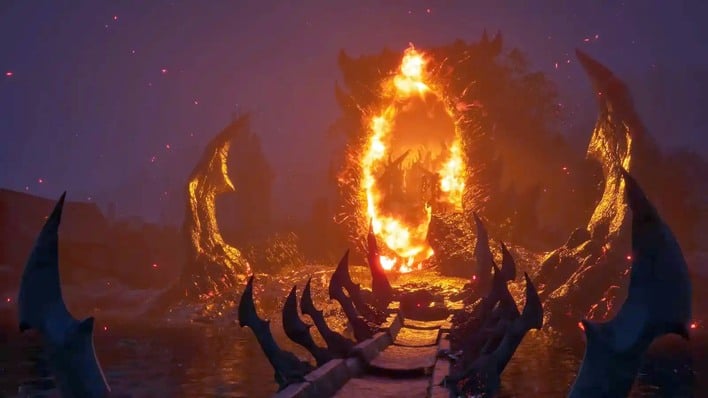Elder Scrolls IV Oblivion Remastered Benchmarked: 8 GPUs Tested
| Hardware Used: Intel Core Ultra 9 285K (Arrow Lake, 5.7 GHz, 8P+16e-Core) MSI MEG Z890 ACE (Intel Z890 Chipset) 2x 24GB Kingston DDR5-8666 MT/s CUDIMMs Toshiba RD400 512GB Relevant Software: Windows 11 Pro x64 (24H2) AMD Radeon Software (25.4.1) NVIDIA GeForce Drivers v576.02 Intel Arc Drivers 101.6737 |
Graphics Cards Tested: AMD Radeon RX 7800 XT 16GB AMD Radeon RX 7600 8GB AMD Radeon RX 6750 XT 12GB Intel Arc B580 12GB Intel Arc A770 16GB NVIDIA GeForce RTX 4080 16GB NVIDIA GeForce RTX 4060 Ti NVIDIA GeForce RTX 3080 |
For our test, we wanted to maximize GPU usage, so we picked an area dense with foliage as that seemed to hit the GPU harder than any of the cities or indoor scenes. We did three runs with each card to ensure consistent performance, and we were careful to restart the game between settings changes to avoid any weirdness. Let's start off with the 1440p results.

These benchmarks were performed in 2560×1440 resolution, with "Quality" upscaling and in-game settings set using the "High" preset. For this testing, we disabled hardware-accelerated Lumen, which means the lighting calculations were simplified and performed without the benefit of hardware ray-tracing accelerators. On the NVIDIA GPUs, we used DLSS 4, while on the Intel and AMD GPUs we used XeSS 2.0.1.
Overall, at these settings, the game definitely favors AMD. The RX 7600 punks the Arc A770 and nips at the heels of the Arc B580, which is normally quite a bit more potent. There's something strange going on with Arc in this game; while GPU utilization is very high, the actual power consumption is relatively low. Meanwhile, the Radeon RX 7800 XT comes in shockingly close to the GeForce RTX 4080, and the Radeon RX 6750 XT dunks handily on the GeForce RTX 3080. What about when we crank the settings up, though?

At these settings, things swap around a bit. We used the "Ultra" preset and "Performance" upscaling for this testing, as well as Hardware Lumen on the "High" preset. Despite the reduced upscaling preset, this is still a higher input resolution than before, and the ultra-high-res textures and ray-traced lighting are brutal on the lower-end GPUs.
Unsurprisingly, the GeForce RTX 4080 leaps out ahead, but the Radeon RX 7800 XT holds its own reasonably well considering the intense ray-tracing workload here. 50.5 FPS average is completely playable. Things get a little dicier as you proceed down the product stack but it's only the Arc A770 and Radeon RX 7600 that aren't really enjoyable at these settings. The little Radeon card is running out of VRAM badly, while Alchemist is struggling under the weight of its GPU driver.
The testbed we used for most of these results is an Intel Core Ultra system, but we also tested the GeForce RTX 4080 in an AMD-powered machine with a Ryzen 9 9900X. The difference was less than you might expect, but also still significant. It likely goes without saying that AMD's socket AM5 CPUs are probably the best option for gamers right now, but the Core Ultra we used is no slouch.

Before we clean up, we wanted to take a look at the power consumption of these GPUs. This chart compares cards by their reported HWiNFO power consumption against their average frame rates from the performance testing above. There are really no surprises here, which is a very good thing: the Ada Lovelace cards perform as expected, while the competitor cards fall varying degrees of behind. Check out that 7.19 watts/FPS on the GeForce RTX 3080.
Elder Scrolls Oblivion Remaster Settings Recommendations
Of course, don't forget to make use of upscaling, particularly new-generation upscaling like DLSS 4 on GeForce cards and FSR4 on the new Radeon RX 9000 cards; the game doesn't support FSR4 natively, but you can force it in the Adrenalin software. Arc and older Radeon users should stick to XeSS, as it will offer the best image quality for those cards; you can update the XeSS DLL with the latest one from Github to trade a bit of performance for improved image quality.
Before you try all of that, though, make sure you hit up our earlier post today that details tweaks you can make to smooth over your performance. In particular, the modified Engine.ini file (linked in that post) has supposedly been improving performance for some players by as much as 30 FPS, so it's absolutely worth trying. Let us know how your experience with the Oblivion Remaster has been in the comments!





